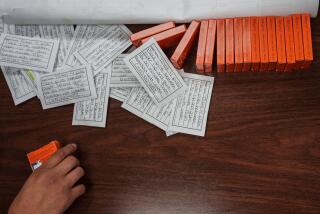Justices Again Broaden Legal Protections for Drug Makers
SAN FRANCISCO — In another major victory for prescription drug makers, the state Supreme Court ruled unanimously Thursday that cancer victims cannot win damages for injury from the drug DES unless they filed suit within a year after they first suspected harm from the product.
The court said the one-year limit must apply even when it appeared at the time that victims could not win their cases.
The decision was the second in a week granting far-reaching protection to the pharmaceutical industry. In another DES case, the court held March 30 that injured consumers could not collect damages unless they could prove that manufacturers were negligent in producing and marketing their drugs.
In Thursday’s decision, the justices rejected contentions that victims who had missed the statutory one-year deadline should still be allowed to sue within a year of a landmark 1980 ruling that had greatly increased their ability to win damages against makers of the now-banned DES.
The court held that the plaintiff in the case, Christine M. Jolly, a 36-year-old social worker from Los Angeles, and others who missed the deadline could no longer pursue their claims against DES makers.
Panelli Writes Decision
Justice Edward A. Panelli, writing the court’s 37-page opinion, acknowledged that the time limit may “work a harsh result.” But, he said, the court could not permit discarded claims to be revived every time it set a legal precedent.
Panelli said the rule justifiably encouraged people who want to change the law to bring suits promptly, and freed defendants from the unfair burdens of responding to “stale” litigation.
“To hold otherwise would allow virtually unlimited litigation every time precedent changed,” he said.
The ruling will probably affect about one-third of the estimated 75 DES cases still pending in California and by implication could be applied to other personal injury cases--such as medical malpractice or toxic waste claims--where plaintiffs have delayed filing suit, attorneys said.
Robert D. Phillips Jr. of San Francisco, an attorney for Rexall Drug Co., said the court’s two new rulings within the week “represent a common-sense balancing of the concerns of plaintiffs, defendants and the public at large.”
“They will allow pharmaceutical companies to shift some of their resources from litigation to research and development,” Phillips said. “But at the same time, plaintiffs who move diligently and have a case they can prove are still going to be able to recover damages without unnecessary barriers.”
Robert E. Schulz of Palo Alto, an attorney for Jolly, said he was “disappointed but not particularly surprised” by Thursday’s ruling.
“We had thought we would prevail until the decision (in the other case) last week,” Schulz said. “The court indicated then that it wasn’t going to do any favors for DES victims.”
DES, or diethylstilbestrol, was an anti-miscarriage product that was taken off the market in 1971 after being linked to cancer in daughters of women who took the drug. Before then, it had been prescribed to an estimated 2 million or more women in the U.S.
The case before the justices arose in the wake of the court’s trailblazing 1980 decision holding that, even when cancer victims could not identify the maker of the DES taken by their mothers, they could still sue makers of the drug collectively and win damages according to each firm’s share of the market.
According to testimony in the case, Jolly learned in 1972 that her mother had taken the drug and that as a result she could suffer injury. She then went to a clinic and was diagnosed as having a precancerous condition.
By 1978, her condition had become acute and she underwent an operation to remove a cervical malignancy. Meanwhile, she had been unsuccessful in trying to learn the identify of the maker of DES that was ingested by her mother.
In March, 1980, in the case of Sindell vs. Abbott Laboratories, the court issued its milestone ruling removing a major obstacle to suits by cancer victims claiming injury from DES.
Sued Several Firms
A little less than a year later, Jolly brought suit seeking damages against Eli Lilly & Co., the Upjohn Co., Rexall and several other companies for injuries she said resulted from DES.
The defendants argued that Jolly’s suit, and others like it, should be dismissed because she had missed the one-year legal deadline for the filing of personal injury suits.
Jolly replied that it would be unfair to require a suit to have been filed before the 1980 ruling, when it had appeared that she would have no chance of winning under the law as it then existed.
In his opinion, Panelli said such suits must be filed within one year of the time the plaintiff “suspects, or should suspect, that she has been wronged.”
‘She Must Decide’
“Once the plaintiff has a suspicion of wrongdoing, and therefore an incentive to sue, she must decide whether to file suit or sit on her rights,” he wrote.
The change in the law that came with the 1980 ruling did not serve as a way of reviving a claim that was otherwise barred by the statute of limitations, he said.
Such a barrier “can obviously create a hardship on some unfortunate plaintiffs (and a windfall to fortunate defendants),” Panelli wrote. But that hardship was no worse than the one suffered by other plaintiffs who sued but lost their cases under previous law and thus, by well-established legal doctrine, are barred from suing again, he said.
More to Read
Inside the business of entertainment
The Wide Shot brings you news, analysis and insights on everything from streaming wars to production — and what it all means for the future.
You may occasionally receive promotional content from the Los Angeles Times.










